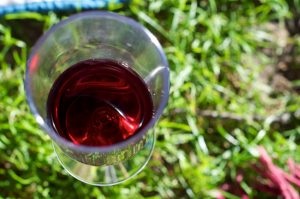Who Says Red Wine Can't Be Refreshing?
Scorching summer days may put you in autopilot, busting out that galvanized ice-filled tub and stocking it with crisp whites and zingy rosés. But considering that this time of year we’re eating a lot of grilled meats, seafood and veggies that have been coated in rubs, sprinkled with seasonings and slathered with barbecue sauce - it often makes more sense to serve a red. If you think it’s too hot for room temperature cabernet though, you’re absolutely right. But there’s a whole other world out there of way cool, scarlet-toned bottles that can handle a little dip in serving temperature.
“Low alcohol, higher acid [red] wines from younger, fresher vintages tend to work best,” believes Thaddeus Miller, sommelier at FARM in Bluffton, South Carolina. This pretty much eliminates big bold options like First Growth Bordeaux, Brunello and most California cabernet or zinfandel, he says. He opts for bottles with an ABV of 13.5% or lower, and is partial to Piemonte offerings including Langhe nebbiolo, dolcetto and barbera. A domestic stand-in made from the same grapes is Wind Gap’ Soif from California’s North Coast. “[It] uses carbonic maceration to produce a vibrantly colored, lip-smackingly refreshing red that wonderfully pairs with just about anything, especially another bottle,” he touts.
Most of us drink all of our reds way too warm, Thaddeus says. This serves to accentuate both their alcohol and tannin--the very elements that sting and burn the palate. But drinking them cool coaxes out their subtle nuances. So how do we get them to that sweet spot? In the backyard, on the beach or in a boat, keep a cooler of ice handy; dunk the bottle in ice for a few minutes, then set it on the picnic table, and repeat as necessary, he suggests. “[And] pour only half glasses--the wine will show better with more surface contact with the air, and won’t allow the wine to warm too quickly.”
At Entyse Wine Bar & Lounge at the Ritz Carlton in Tysons Corner, Virginia, director of restaurant and wine director Vincent Feraud offers cooler reds on tap, including Demazet Vignobles Côtes du Rhone, a full-bodied, peppery red made with syrah and grenache that shows dark fruits and soft tannins. Feraud says keeping reds a bit on the cool side will keep the fruit front and center and the alcohol content less apparent. To replicate this at home without a bucket of ice, he suggests put a red in the fridge for half an hour (or more, depending on wine style and preference) before drinking it.
Fruit-forward reds with soft tannins are best served semi-chilled, agrees John Moynier, winemaker for Purple Heart Wines, like gamay, nebbiolo and pinot noir. He defines “slightly chilled” as 50 degrees, and recommends an hour in the fridge followed by twenty minutes on the counter before uncorking. Purple Heart is 67% merlot and 19% zinfandel; he believes the former’s ripe fruit and the latter’s spice transform it to the ultimate barbecue and grilling wine when it’s lower than room-tempy. “Even though a white wine or a beer might seem like a better fit for the weather, the best pairing for these foods remains red wine, [and] by chilling your reds, you can achieve the best of both worlds.”
In addition to wines with low tannins, those with high acidity can be more enjoyable with their temperature turned down a bit, says Gabriel Geller, director of public relations for Royal Wine Corp., including Chianti Classico and other Tuscan red blends.
Joel Mesa suggests looking towards cool climate wine regions like northwest Spain. Better known for its albariño and godello, many of its reds are as of yet undiscovered, says the mixologist who oversees all cocktail creations at Centurion Restaurant Group (locations across the country). “Mencia grows exclusively in this area of the world and produces delectable aromatics centered around red fruit and floral notes,” he points out. “The refreshing acidity in these wines makes it the right beverage to have in summer weather."
Here are some really cool reds to quaff this summer:
2013 Pago de Valdoneje Roble Mencia (from Bierzo): “A slightly more concentrated and intense example with layers of complexity involving oak, black cherry and earthy aromas, [yet] the acidity is still vivid and present,” Mesa says.
Pena do Lobo Mencia (from Ribeira Sacra): Mesa calls this a complex yet very drinkable wine full of red cherry and plum notes and vibrant acidity.
2015 Wind Gap Soif: “Explosive aromas of sweet red cherries, cinnamon, fresh summer fruits and crazy floral notes, with “palate weight that doesn’t sacrifice the lift and verve.” The producer recommends drinking it chilled and frequently.
2015 Purple Heart Red Wine Sonoma County: A collaboration between C. Mondavi & Family and the Purple Heart Foundation, this wine crafted from Sonoma fruit has aromas of cedar, plums, blackberries and blackcurrant with hints of black licorice. Medium-bodied, it has a long, velvety mouthfeel with finely balanced tannins; it will continue to gain complexity over the next four to five years.
2015 G.D. Vajra Langhe Rosso: “This wine shows beautifully fresh notes of ripe red raspberries, and Morello cherries just picked this morning. It is hard not to note the aroma from childhood of grape flavored Hubba-Bubba. Vajra pairs beautifully with any dish you would traditionally serve at backyard BBQ,” Miller says.
Bartenura Rosso Toscano: “This Tuscan wine is made from 100% Sangiovese grapes. A light to medium-bodied wine with hints of fresh fruit and olive aromas; flavors of red berries with a crisp acidity and long finish,” the producer says.
2016 Estancia Reserve Pinot Noir, Monterey County : The silkiness of this pinot noir with its dark cherry, boysenberry and ripe late summer plum flavors are ideal served with a slight chill. This double gold medal-winning wine from the 2018 NY International Wine Competition is a natural match for barbecued salmon, pork chops, grilled tomatoes and even a skirt steak.





